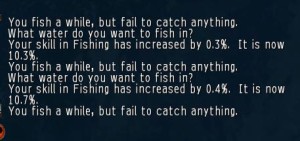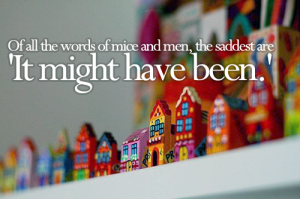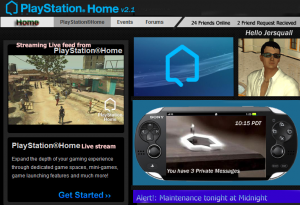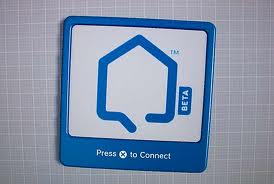Home Consumers: Getting What They Want, Not What They Need
“It’s perfectly fine to have a metaverse with leaderboards and achievements on display, but that’s not enough. Any metaverse must have an independent reason to exist, or it will ultimately fail.”
–Richard Garriott’s summation of Home
Study Home long enough, and some interesting clues emerge. Even given the lack of hard data, it is possible to make reasoned inferences based on what’s happening, much as an astrophysicist uses Doppler spectroscopy to prove that a distant star has a planet orbiting it, even if the planet cannot be directly observed.
In this case, there’s sufficient data to suggest a general reduction in SCEA Home’s net profitability, or at the very least a drop in how lucrative it is perceived to be to larger investors, including the powers within SCEA itself that approve Home’s annual operating budget. It’s entirely possible that I’m completely wrong, but the data is difficult to ignore. And this is important because in recent months the Sony forum has gotten excessively loud with its whining over how expensive Home seems to be compared to years past — an emotional knee-jerk reaction which we will examine momentarily — and because we have people on that forum operating under the false belief that SCEA and the third-party developers involved with Home (both foreign and domestic) are raking in piles of cash, which simply isn’t true.
If that forum is to be believed, the key to Home’s fiscal success lies in more subsidized freebies from SCEA, somehow magically convincing prominent outside developers to commit the cost necessary to create game-related content for Home, and hard price ceilings from four years ago. Leaving aside any commentary on self-entitlement, the cold truth is that it wouldn’t change a damn thing.
Consider the following question: If Home was so lucrative and successful, why are the content developers for it getting smaller instead of larger?
I’m not the only one who’s noticed that all the new developers for Home — Game Mechanics, Atom Republic, Bigyama, JAM Games and so forth — are very small operations, usually staffed by no more than one or two people. Meanwhile, heavyweights like EA, Disney and LucasArts are done, and have been for years. New content related to hot AAA game releases or blockbuster movie IPs is minimal at best, and we can only speculate as to how much money SCEA laid out to subsidize what content — such as the Journey public space — that was released in Home. Content which historically has made no attempt at monetizing, and is undoubtedly difficult to measure in terms of tangible sales impact for the products being represented.
 There’s only one logical business reason for Home’s developers getting smaller: Home isn’t sufficiently lucrative to the big boys.
There’s only one logical business reason for Home’s developers getting smaller: Home isn’t sufficiently lucrative to the big boys.
I know there are people on the Sony forum constantly complaining about the lack of game-related content in Home, or the fact that other regional Homes (SCEE, SCEJ, etc.) still have game-related spaces while SCEA Home has pulled them. The answer is so bloody obvious that no one wants to acknowledge it: these things don’t exist any more — and aren’t being created for SCEA Home in large numbers — because they aren’t worth the cost.
If Home’s consumer base was really driven to own game-related virtual merchandise, and the sales figures reflected this, then you’d logically see large developers committing the cost and resources to develop more of that content for Home. If Ford, for instance, realized any measurable gain in sales from its promotional effort in Home (remember that?), Ford might still be in Home.
This is why I’ve learned (far too late, perhaps) to take that forum with a very large grain of salt: because they want all that game-related content, all right — they’re just not willing to pay for it.
The root of this problem, however, is how Sony structured and deployed Home.
Before diving into this problem, however, I want to point out that this problem existed long before the Digital Platforms team took over. The problem lies with whomever in Sony, half a decade ago or more, decided that Sony’s official social network for its gaming audience would be a footnote on the PS3, rather than the focal point.
Leaving aside the technical hurdle of trying to engage a user with a program that more or less requires a keyboard (a piece of hardware which is not bundled with the console), the biggest problem is that while Sony’s original concept of a console-based social network for gamers is brilliant, it’s not mandatory.
The way to make Home — or any other concept like it — work on a game console is to make it the focal point of the console. To make it synonymous with the console and brand experience. So that when you boot up your PS3, the first thing you see isn’t the 2D XMB: the first thing you see is your avatar inside Harbour Studio, providing a 3D interface that provides all the same functionality as the XMB (and is capable of working offline) while the rest of the Home application loads as quickly as possible in the background.
That one difference would have made all the difference in the world. Because Sony would then be sending a clear message: from your Home, experience the world of PlayStation. And come back Home and socially network with your friends when you’re done with your latest gaming session.
That one difference would have introduced the entire PS3 user base to Home, making it far more lucrative as an advertising and marketing platform for every single PlayStation content provider. It would have allowed SCEA to take its current laissez-faire approach to Home without negative repercussion, because Home would be synonymous with the PS3 experience itself. And it frankly would have saved Sony some money, as they wouldn’t have had to subsidize so many promotional events and so much content — the Total Game Integrations, the Hub, the holiday-themed events, etc. — in repeated attempts to attract users to the platform.
Instead, Home is a self-contained experience, buried in the XMB, that is voluntarily enjoyed by only a small fraction of the PlayStation user base. And it has thus gained a reputation as being an empty cesspool of quaint amusements and socially maladjusted troublemakers, condemned to never be more than an afterthought in the greater PlayStation pantheon.
Therein lies the great tragedy of Home: it is a remarkable concept — a social network for gamers — that never had a chance to be more than it is because it wasn’t given the scope it needed. As an optional program to explore, it is doomed to forever be unfavorably compared with the gaming experiences it was originally designed to promote. Is it thus any wonder that larger content developers have withdrawn or scaled back from it, and Sony made the strategic decision to shift it into a self-contained gaming platform? It was the only logical move that could be made, even though it meant completely abandoning Home’s original purpose.
 Home is at its best when it feels like it’s connected to the rest of the gaming world. The more connected it is, the less of a stigma the user feels for opting to spend time with it. But the only way to make Home lucrative enough to the outside gaming world is to make it a mandatory experience for the entire console user base, and that was a decision that should have been made — and implemented — when the current console generation started. Today it’s far too late. And, without that lucrative attraction to larger content developers, the SCEA authorities who approve Home’s operating budget have to scrutinize just how profitable it is as a self-contained business unit.
Home is at its best when it feels like it’s connected to the rest of the gaming world. The more connected it is, the less of a stigma the user feels for opting to spend time with it. But the only way to make Home lucrative enough to the outside gaming world is to make it a mandatory experience for the entire console user base, and that was a decision that should have been made — and implemented — when the current console generation started. Today it’s far too late. And, without that lucrative attraction to larger content developers, the SCEA authorities who approve Home’s operating budget have to scrutinize just how profitable it is as a self-contained business unit.
I suspect the answer is that Home isn’t very profitable at all — particularly given all the free promotional events that Sony has paid for to try to drive user engagement. Five years (if you include closed beta) is an awfully long time to support a single program in the console gaming world. And it would explain why the Home Community Management team was folded into the larger Digital Platforms initiative; if their former Home-centric roles were not fiscally justifiable, then the logical course of action is to expand the scope of duties.
Of course, here’s the other catch with turning Home into a game platform: it sacrifices the idea of monetizing users who are interested in the game of Home itself.
Home works as a social network for gamers first, and a gaming platform second. But since it’s not a mandatory experience for the PlayStation user base, its appeal as a social network is very low. Which means that the games have been emphasized instead. Which, to some extent, is fine; Home games, if developed correctly, can monetize over a significant length of time, just as simplistic freemium Zynga games rake in huge numbers off small numbers of people on Facebook. The difference, though, is that Facebook is first and foremost a compelling social network to use; the point of Facebook is to socially network, and the gaming is a bonus.
The problem with Home is that it’s become first and foremost a gaming experience, and its core strength of being a social network has languished.
Here’s the reason why this is a problem: Home has no reason to exist.
Oh, from a business standpoint, it has a reason to exist. But from a user standpoint, why does the universe of Home itself exist? The key to behavioral economics is figuring out what someone is willing to buy, not just what you want to sell.
The problem with Home being a decentralized gaming platform is that there are very few games in Home which actually feel like they work because of Home, as opposed to being self-contained experiences that happen to be hosted in Home. And while such amusements are fun, we have to look at the fact that the game of Home itself has been largely abandoned.
What do I mean by “the game of Home”? Simple. What social activities — including meta-games — do people indulge in with Home, and how has this been encouraged and monetized by Sony itself as the platform provider?
Off the top of my head, the following social meta-games make up the game of Home itself:
- Glitching
- Estate decoration
- Fashion
- Dancing
- Flirtation
- Clubs
- User-created content (machinima)
- Avatar customization
And there are two parts to making these meta-games feel like a vibrant community with a central focus: sell commodities to enhance the experiences, and then publicly recognize, in world, the users who excel in these areas.
The problem with Home is that there’s a whole hell of a lot of the former, and not nearly enough of the latter. And with only half the equation in place, this is bound to lead to diminishing returns.
Start with this behavioral economics question: why does someone buy something — anything — in Home, if it’s not directly related to a game?
That’s your primary motive, right there. Sure, some sales will be based solely on novelty, but by and large, if you’ve convinced someone to buy any sort of commodity — furniture, clothing, etc. — which enhances their virtual experience, chances are good that they’re doing it because they want to show it off to others.
And herein lies the current problem Home is facing: an embarrassment of riches.
There came a tipping point with Home’s economy — either in late 2010 or early 2011 — when it was no longer possible or feasible to keep track of everything being released into Home (years which may have been, economically, Home’s “peak oil” period). This problem only accelerated through 2012. Granted, it sounds like a strange “problem” to have, but again: look at why people are buying what they’re buying. In a Home where content is scarce, one method of being prominent and socially significant is to own everything that’s for sale. But in a Home where there’s too much content coming out for (nearly) anyone to economically afford to purchase, two things happen:
A.) Users begin complaining about pricing.
B.) Users begin to feel insignificant, and — worse — grow to resent the money they sank into what they bought previously, due to the perceived loss of status.
 The problem is not escalating prices. The problem is not that Home was flooded with useless junk. The problem is that too much good stuff — stuff that people want to own, and in some cases have been requesting for years — finally made it in. So how do you feel significant — how do you satisfy the ego drive to purchase something if you want the feeling of status that goes with it — in an environment where there’s too much to keep track of, and even cooler stuff coming with each successive week? If you can’t be seen as the queen bee who can afford to own everything, then why buy any of it?
The problem is not escalating prices. The problem is not that Home was flooded with useless junk. The problem is that too much good stuff — stuff that people want to own, and in some cases have been requesting for years — finally made it in. So how do you feel significant — how do you satisfy the ego drive to purchase something if you want the feeling of status that goes with it — in an environment where there’s too much to keep track of, and even cooler stuff coming with each successive week? If you can’t be seen as the queen bee who can afford to own everything, then why buy any of it?
(In fact, why not be seen as the person spearheading the movement to stop it, disguised as the voice of concern for the welfare of the community? Wouldn’t that be a nifty way of substituting an expensive ego boost for a cheap one instead?)
The Home community got exactly what it wanted — just not what it needed.
And the end result, if I’m interpreting this data correctly, is a drop in overall sales revenue.
Look at SCEA’s top-ten sales lists (by number of units sold) over the last two years. Clothing is gone. Estates are gone. Furniture is gone. They’ve slowly been replaced by gaming consumables. Avatar locomotions will for a time occupy one or two spots on the list — because it’s a new market segment that isn’t completely saturated — but they too will in time diminish. What’s telling is that the only non-gaming consumable which has shown any longevity on the sales lists is Lockwood’s Gift Machine tokens, because Lockwood figured out that making desirable commodities slightly harder to purchase was a nifty method of making them more desirable without having to play pricing games for exclusivity.
The question is, though, did this shift in Home’s business model — from emphasizing social commodities to gaming commodities — actually produce more net revenue for SCEA? The evidence circumstantially suggests that it didn’t. Again, I could be completely wrong, but I don’t think I am. If Home were truly more profitable now than in the past for Sony, then logic dictates they would be overtly committing more resources to it.
This does not mean that Sony hasn’t spent a bucket of money on Home. The Total Game Integrations, holiday events, and a whole bunch of other subsidized experiences all cost a fortune, and frankly there are a lot of people on the Sony forum who simply take these things for granted. And we still get at least two major core updates per year. But that doesn’t mean that Sony has necessarily been smart with its expenditures. A good example of a waste of money would be the Hub and its related districts: yes, it “reskinned” Home, but did it actually do anything to fundamentally change or enhance the Home experience for the user? Did the Hub make it easier to explore Home and expose the consumer to all the various third-party attractions? Did the Hub do anything better than Central Plaza at communicating the Home experience itself? Did it make the game of Home itself any more interesting?
Here’s the catch: making Home itself more of a game — making the social experience more engrossing, and publicly recognizing consumers who play the social game itself — requires developing and implementing multiple features, all of which cost money and manpower. And while it would be a good idea for Sony as the platform provider to commit such resources, I realistically don’t see that happening. It’s an expensive proposition to so completely rework Home, and though it is frankly the right thing to do, it cannot be as easily quantified as the current strategy of turning Home into a gaming platform. Which is a damn shame, because the key to any successful social network, regardless of platform, is how easy it is for users to share and show off to each other in a public environment.
In this regard, Home isn’t particularly effective. Psychologically, gamers are used to objectives, rewards and ego gratification for achievement. But when you step into Home, you get the overwhelming sense that nothing you do matters.

Something this simple: a job, a reason for social interaction, an internal economy. Lockwood already did this with Sodium.
And as Home has gotten bigger — more people, more things to buy — this sense of anonymity has only increased. The only two ways to sidestep this problem are to either empower users to create their own content (Second Life), or to create an internal economy in which there are jobs and resource bartering (Ultima Online). Neither of which is likely to happen. Home has held on, in large part, simply because there’s nothing else like it. And at this point, the odds are quite low that Home will be overhauled into a truly robust social network for gamers.
So, what does this mean for Home’s future?
Realistically, barring a large-scale commitment of funds and manpower from Sony to overhaul Home as a social network for gamers — now that it’s solidified itself as a gaming platform — it’s possible that 2013 may be Home’s last big hurrah. Oh, I don’t mean it’ll be shut down right away, but at some point, we’re inevitably going to see less content being created for it and less SCEA resources devoted to it, as it churns along even more quietly in the background. I don’t think 2013 is going to be that year, but I do think 2013 is going to be the last year that Home sees any sort of overt growth. And then we, as a community, have to decide how we define ourselves.
Think about it. How many times have you seen someone on the forum cavil, “Oh, I lost interest in Home long ago; I just check in once a week to see what’s new.”
Wow. Do we as a community really define ourselves as nothing more than freebie trinket collectors? If that’s all we are, then let’s drop this pretense of having ever been a “community” at all.
A community finds itself — or finds itself lacking — when it is tested. Frankly, it has failed the test of largesse. As more and more communal wishlist items were fulfilled, the community simply balkanized further and further. Part of this is a consequence of how Home is set up. And part of it is a direct reflection of what we as its consumers wanted. What we really wanted, according to the sales lists. The next test of the community comes very soon, and it starts with a cold truth.
The cold truth is this: time is running out. The Digital Platforms team has a lot more on its plate than just Home, including a brand-new platform — the Vita — to support. And with a new console generation coming up quickly, it seems unlikely to expect Home will receive more than what it did in 2012: two (perhaps three) core updates, and plenty of additional commodities and gaming experiences which further decentralize the Home experience into clustered micro-communities around gaming experiences. Until, eventually, the flow of new content slows (and later stops) — at which point, if the doors are kept open, the true test of the community will begin.
This isn’t necessarily a bad future. It’s just less than what Home ultimately could have been. What could have been the killer app for an entire console generation turned out to be little more than a footnote. And that’s a shame. Home’s third-party developers have done an amazing job bending and twisting the platform to create some amazing experiences and virtual commodities; though Home itself has no purpose, it is a far more entertaining diversion than it was when it started.
 Again: I do genuinely hope my instincts are wrong. I hope there are unimaginably brilliant plans for Home 2013 that Foster City is planning on unveiling, in order to give it direction and purpose unto itself. I hope Home is raking in buckets of cash. But every piece of circumstantial evidence that’s available to the general public indicates that this isn’t the case.
Again: I do genuinely hope my instincts are wrong. I hope there are unimaginably brilliant plans for Home 2013 that Foster City is planning on unveiling, in order to give it direction and purpose unto itself. I hope Home is raking in buckets of cash. But every piece of circumstantial evidence that’s available to the general public indicates that this isn’t the case.
So. What does this mean?
Well, if you’re a developer, the obvious answer is to look at how best to migrate your in-Home audience to projects outside of Home, either on another PlayStation platform or elsewhere. This doesn’t mean Home should be abandoned — quite the opposite — but I do have some concerns for developers who are solely Home-centric.
And if you’re a consumer? Enjoy the ride. For all of Home’s flaws — for everything that Home could have been, and isn’t, and likely never will be — it’s still a hell of a lot of fun to enjoy for what it is. And, to an extent, I applaud what Sony has done with Home. I don’t agree with all of their decisions, but I do appreciate what they’ve done to try to keep Home viable as the years have gone on, considering the flawed foundation upon which it rests. Home 2012 was the Year of the Game, but it was also the year in which a lot of community wishlist items finally came true. And for what it’s worth, Home 2013 looks like it’s going to be a hell of a lot of fun. It may not be the Home we needed, but it ultimately is the Home we wanted.
And Home itself? The great question is whether or not it will somehow, in some way, appear on the PS4. Personally, I doubt it. The best-case scenario I’m hoping for is a clean-sheet redesign of Home for the PS4, built with today’s architecture, using everything Sony’s learned since 2007. Whether or not it happens is another matter entirely — it’s also equally plausible that Home will end with the current generation — but either way, let’s enjoy the time we have left, because Home is indeed something special.







 LinkedIn
LinkedIn Twitter
Twitter
Ah yes… whether it appears on the PS4 which could be next year or the year after. Or perhaps Sony’s game consoles will fail. Nintendo did but made a comeback.
Small developers perhaps have more imagination and derring do. But I don’t know if Granzella is large small or medium.
Think what one will of Xi2 and I think it stinks, it seems to have captured the imagination of some. I don’t know how many but I do play.
What data?
What’s the next big thing? Perhaps Home itself?
The world economy may have a lot to do with what happens with Home or anything video.
I know what I’m talking about but I just don’t understand it which is why I’m not a writer of fact or fiction articles.
There isn’t a whole lot of hard data to work with, beyond Sony’s top-ten sales lists (by number of units sold) — and even there, the data is vague.
Consider, though: SCEA-developed commodities don’t even show up on the sales lists any more. Yes, SCEA as the platform provider gets a *percentage* of third-party sales, but unless the sales numbers are truly astronomical for gaming consumables, that’s a hell of a deficit to make up.
Also consider that investment from large developers — LucasArts, for instance — is non-existent. Home’s new development houses are smaller, not larger, than years past. This isn’t a knock against Home’s developers; to the contrary, it’s *amazing* to see what they’re doing with core architecture that was originally designed for the PS2. But if Home isn’t pulling *large* developers the way it used to, that’s a contextual clue as to the overall financial performance of the platform.
My personal hope is that the PS4 will have a clean-sheet redesign of Home, built on today’s architecture — a new Home which is fully integrated with the console experience itself, so that a 3D avatar interface is simply the norm for every console user. Otherwise, a newer version of Home would simply be a scaled-up version of the same formula the current Home employs. And that formula can be so much more.
ok, Norse. Thank you. And good luck to us all.
Sometime home reminds me of the early version of MsWindows. A graphic interface running on top of a basic operating system. It was akward, buggy and used up a lot of our old PC limited ressources. But today no one would go back to the black screen of a basic DOS with typed commands.
Sony failed to draw a significant number of users in home. Maybe due to the lack of content on release day. Gamers are not necessarly chatters, especially the older one. If I had not hooked my PS3 on the net 2 days into the outage. I spent a month reading the official blog and forums looking for info as to when the PSN would be back online. Thats where the enthusiam from home user lured me into giving a shot at this virtual environnement thing.
I don’t think any console will use a 2D, blank screen menu system in 2025. But sadly, I’m affraid we will skip at least 1 console generation.
I had this in mind, no doubt to talk about Home’s current state. I personally feel this:
Home has sunk into this stoop hole to obsecurity. More items, more locomotions, all of this has weaken the structure of Playstation Home’s number one experience: socializing.
Everything has become a popularity contest, all content is loosely based on gaming commodity, nothing to deepen the experience for any Home User that desires something different. While I think it’s almost too early to provide a sense of realm on where Home would be at this stage, the fact of a matter is we all miss the social structure presented in Home.
I think I will touch upon this a bit more. Thanks Norse for sharing your thoughts on this.
Home users are homes worst enemy sometimes, as we sit there behind our ps3’s, praising and even advertising the very articles and items the that are destroying homes social experience, blindly sticking up for items and experiences that are poor. It feels like supporting your favorite sports team some times, you cant say a bad word against them even if they did play poorly. On the other side of that others go completely the opposite saying they are leaving home and giving away they playstations to the local charity shop when home has a small hiccup. Why would big developers want to get involved with that rubbish . plus the product isnt that stable with crashes maintenance lag etc. I go shopping for food, no other shopper in there tells me i should buy this or screams at me dont buy it, if they did i would think freak lol sometimes back to basics are needed so perhaps a ps4 revamp is needed
I think it would help if Sony spent maybe 10 minutes during their next E3 presentation talking about how Home has evolved and grown, showing the latest games and some of the new stuff they’re releasing for it down the line. A lot of people haven’t given Home a second glance since it first released, so if Sony was to give it some better spotlight, then those same people and many more could end up being impressed.
Surprising how similar our conclusions get with different arguments.